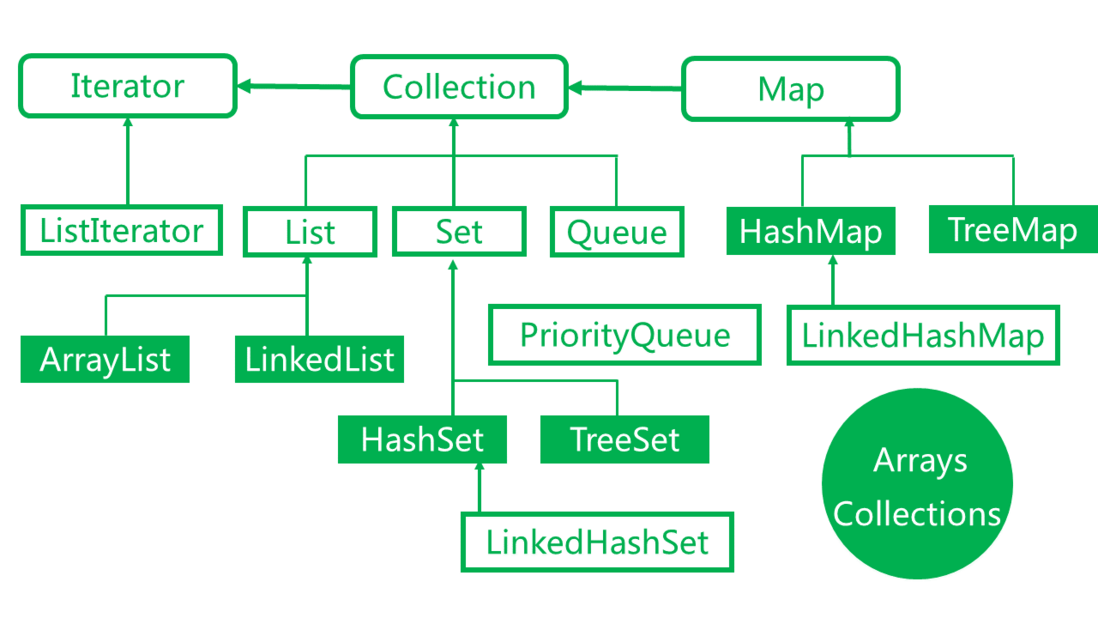网上找了一张图,可以整个概况容器的整个结构
容器概念
容器接口是容器的基础。使用接口可以将容器的实现与容器接口分开,因而可以使用相同的方法访问容器而不需关心容器具体的数据结构。Iterator接口也使用户能够使用相同的方法访问不同的容器类。
容器API
- Collection 接口,定义了存取一组对象的方法,其子接口set和list分别定义了存储方式
- Set中的数据对象没有顺序且不可重复
- List中的数据对象有顺序且可以重复(equals)
- Map接口定义了存储“键(key) –值(value)映射对”的方法(一对一对往里装)
Collection接口中所定义的方法
容器类对象在调用remove,contains等方法时需要比较对象是否相等,这回涉及到对象类型的equals方法和hashcode方法,对于自定义的类型,需要重写equals和hashcode方法以实现自定义的对象相等规则(相等的对象应该具有相等的hash codes)
|
|
Iterator接口
所有实现了collection接口的容器类都有一个iterator方法用返回一个实现了iterator接口对象
Iterator对象称作迭代器,用以方便的实现对容器内元素的遍历操作
|
|
Collections
Collections工具类提供了大量针对Collection/Map的操作,总体可分为四类,都为静态(static)方法:
排序
- reverse(List list):反转指定List集合中元素的顺序
- shuffle(List list):对List中的元素进行随机排序(洗牌)
- sort(List list):对List里的元素根据自然升序排序
- sort(List list, Comparator c):自定义比较器进行排序
- swap(List list, int i, int j):将指定List集合中i处元素和j出元素进行交换
- rotate(List list, int distance):将所有元素向右移位指定长度,如果distance等于size那么结果不变
查找和替换
- binarySearch(List list, Object key):使用二分搜索法,以获得指定对象在List中的索引,前提是集合已经排序
- max(Collection coll):返回最大元素
- max(Collection coll, Comparator comp):根据自定义比较器,返回最大元素
- min(Collection coll):返回最小元素
- min(Collection coll, Comparator comp):根据自定义比较器,返回最小元素
- fill(List list, Object obj):使用指定对象填充
- frequency(Collection Object o):返回指定集合中指定对象出现的次数
- replaceAll(List list, Object old, Object new):替换
同步控制
Collections工具类中提供了多个synchronizedXxx方法,该方法返回指定集合对象对应的同步对象,从而解决多线程并发访问集合时线程的安全问题。HashSet、ArrayList、HashMap都是线程不安全的,如果需要考虑同步,则使用这些方法。这些方法主要有:synchronizedSet、synchronizedSortedSet、synchronizedList、synchronizedMap、synchronizedSortedMap。
特别需要指出的是,在使用迭代方法遍历集合时需要手工同步返回的集合。
设置不可变集合(TODO)
常见的容器比较
ArrayList VS LinkedList
- 因为Array是基于索引(index)的数据结构,它使用索引在数组中搜索和读取数据是很快的。Array获取数据的时间复杂度是O(1),但是要删除数据却是开销很大的,因为这需要重排数组中的所有数据。
- 相对于ArrayList,LinkedList插入是更快的。因为LinkedList不像ArrayList一样,不需要改变数组的大小,也不需要在数组装满的时候要将所有的数据重新装入一个新的数组,这是ArrayList最坏的一种情况,时间复杂度是O(n),而LinkedList中插入或删除的时间复杂度仅为O(1)。ArrayList在插入数据时还需要更新索引(除了插入数组的尾部)。
- 类似于插入数据,删除数据时,LinkedList也优于ArrayList。
- LinkedList需要更多的内存,因为ArrayList的每个索引的位置是实际的数据,而LinkedList中的每个节点中存储的是实际的数据和前后节点的位置。
concurrent(TODO)
JDK5之后新增的java.util.concurrent包下的集合类

